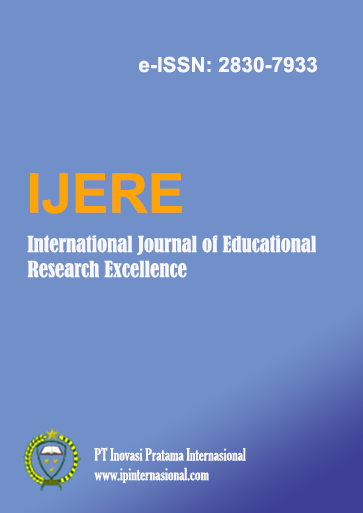An Analysis of Students’ Speaking Ability in Retelling Story on Descriptive Text at D3 Midwifery
Main Article Content
Abstract
This research aimed to assess students' speaking abilities and identify the most common issues faced by students at Akbid Baruna Husada Sibuhuan. This research analysed students' speaking challenges based on five components: pronunciation, grammar, vocabulary, fluency and comprehension. This research was conducted qualitatively. The number of samples obtained only 21 students. The researchers employed a speaking exam. The Instrument for research. This study used video students' performance when retelling descriptive material. Then the researcher transcribed the videos into scripts and asked raters to submit scores. The study indicated that students' speaking ability in repeating stories had an average score of 3, indicating a good level. The articulation component, the students' cruel score was 2.8 focuses, where as linguistic use got 3.5 focuses. Taking after that, lexicon component was 3.2 focuses, then again on familiarity, it was 2.7 focuses. The final, the students' normal score on the component of comprehension was 2.8 focuses. At long last, it can be concluded that the most prevailing issue confronted by understudies in talking was the familiarity component.
Downloads
Article Details

This work is licensed under a Creative Commons Attribution 4.0 International License.
References
Afriantina, T. (2015). An Analysis of Students Speaking Ability on Debate of The Third Semester Students of FKIP UIR Pekanbaru. Pekanbaru: Islamic University of Riau.
Bone, J. C., Jose, A. S., & Concepcion, M. R. (2019). Improving English Speaking Abilities of ESL Learners Through Communicative Task Based Instruction (International Approach). International Journal of New Economics and Social Sciences, 312.
Brown, H. D. (2001). Teaching by Principles: An Interactive Approach to Language pedagogy Second Edition.Longman.
Brown, H. D. (2003). Language Assessment - Principles and Classroom Practice. Pearson ESL.
Bryman, A. (2012). Social Research Methods, Fourth edition. New York: Oxford University Press Inc.
Crystal, D. (2008). A Dictionary of Linguistics and Phonetics Sixth Edition. USA: Blackwell Publishing.
Gay, L. R., Mills, G. E., & Airasian, P. (2006). Educational Research: Competencies for Analysis and Applications Tenth edition. United States: Pearson Education, Inc.
Harris, D. P. (1996). Testing English as a Second Language. New York: McGraw-Hill Book Company.
Hewings, M. (1990). Pronunciation Practice Activities:A resource book for teaching English pronunciation. Cambridge University Press
Hirai, A., & Koizumi, R. (2009, April 02). Development of a Practical Speaking Test with a Positive Impact on Learning Using a Story
Ilham, Bafadal, M. F., & Muslimin. (2019). The An Analysis of Students’ Speaking Ability on Specific Purpose of Learning. Linguistics and English Language Teaching Journal, 7.
Rosmiaty, Ratnawati, & Hasnilatuk. (2019). Students’ Ability in Using Direct and Indirect Speech of English Department Students at Universitas Muslim Indonesia. ELT Worldwide, 6 (1), 73–82.
Rukmaryadi, Zaim, M., & Anwar, D. (2020). An Analysis of Non-English Department Students’ Speaking Ability at Universitas Riau. Advances in Social Science, Education and Humanities Research, Proceedings of the 2nd International Conference Innovation in Education (ICoIE 2020), 504 Retelling Technique. Language Assessment Quarterly, pp. 153-154.
Hughes, R. (2011). Teaching and Researching Speaking Second Edition. Great Britain: Pearson Education Limited.
Kane, T. S. (2000). The Oxford Essential Guide to Writing. New York: The Brekley Publishing Group.
Morrow, L. M. (2015). Retelling Stories: A Strategy for Improving Young Children's Comprehension, Concept of Story Structure, and Oral Language Complexity. The Elementary School Journals.
Oshima, A., & Hogue, A. (2007). Introduction to Academic Writing, Third Edition. New York: Pearson Education, Inc.
Pawlak, M., Waniek, E., & Klimczak. (2015). Issues in Teaching, Learning and Testing Speaking in a Second Language. London: Springer Heidelberg.
Redman, S. (1997). English Vocabulary and Use: Pre-Intermediate & Intermediate. United Kingdom: Cambridge Univertsity Press.
Richards, J. C. (2008). Teaching Listening and Speaking From Theory to Practice. New York: Cambridge University Press. Richards, J. C., &
Schmidt, R. (2010). Dictionary of Language Teaching & Applied Linguistics. Great Britain: Pearson Education Limited.
Rinanda, A. (2017). An Analysis of Speaking Ability of the Second Year Students at MTs Hasanah Pekanbaru. Pekanbaru: Islamic University of Riau.
Rosbaida. (2017). The Effect of Send AProblem Technique Towards Students' Writing Ability on Descriptive Textof the Second Year at SMAN 1 Inuman. Pekanbaru: Universitas Islam Riau.
Sudaryono. (2017). Metodologi Penelitian. Jakarta: Rajawali Pers. Yahla, R. (2013). The Impact of Using Written Retelling Strategy on Improving Reading Comprehension Achievement and Retention for Ninth Graders in Palestine. The Islamic University of Gaza.
Yanti, R. (2017). A Study on Student' Speaking Ability at the Third Semester Students in English Study Program of FKIP UIR Pekanbau. Pekanbaru: Islamic University of Riau.
Ilham, Bafadal, M. F., & Muslimin. (2019). The An Analysis of Students’ Speaking Ability on Specific Purpose of Learning. Linguistics and English Language Teaching Journal, 7. https://core.ac.uk/display/287152526
Rosmiaty, Ratnawati, & Hasnilatuk. (2019). Students’ Ability in Using Direct and Indirect Speech of English Department Students at Universitas Muslim Indonesia. ELT Worldwide, 6 (1), 73–82.
Rukmaryadi, Zaim, M., & Anwar, D. (2020). An Analysis of Non-English Department Students’ Speaking Ability at Universitas Riau. Advances in Social Science, Education and Humanities Research, Proceedings of the 2nd International Conference Innovation in Education (ICoIE 2020), 504

